I have lots of synthetic fabrics in my closet. Up until now, I never realized some of my clothes also contain fabric made from polyamide fibers. In fact, it’s one of the most popular synthetic fabrics used for garments. But, what is polyamide fabric? From polyesters to lycra blends.
Polyamide fabric is a stretchy manmade material better known as nylon. It’s a durable synthetic used for tights, outerwear, and swimsuits. Although it is resistant to everyday wear, the fabric is prone to damage from too much sun, heat, and overstretching.
A useful, versatile fabric, polyamide fibers have been with us for decades. Read on to find out more about polyamide fabric, from its pros and cons to the items it can make.
What Is Polyamide Fabric?
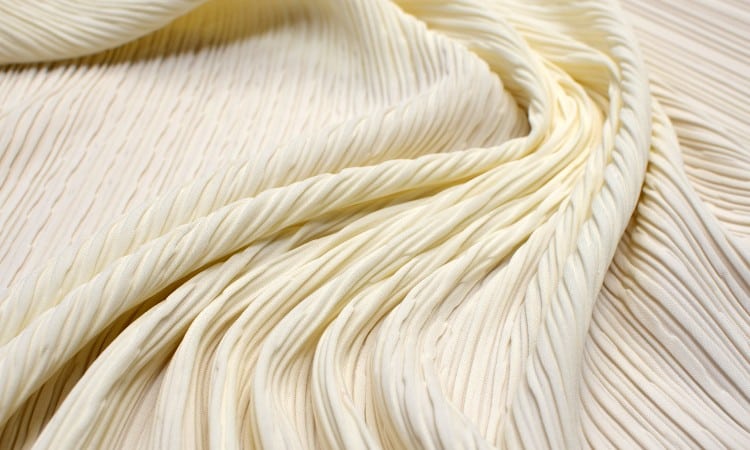
When you hear the name polyamide, it’s easy to think it’s some form of polyester. Polyamide fabrics can be synthetic and are therefore presumed to be plastic. But, they aren’t members of the polyester family. Although the name would suggest it should be polyester, the artificial form is known as nylon.
Polyamide fabrics aren’t always made from synthetic materials. Polyamide is a term used to describe the molecular structure of the fiber, regardless of whether it’s artificial or organic. Natural fibers like silk and wool are classed as polyamides. To understand why the polyamide genome can be used to cover both types of fiber, we need to look at the chemistry behind the terminology.
As the most popular plastic-based fabric is called polyester, it can be tempting to think the prefix “poly” stands for plastic. It doesn’t. Poly comes from the word polymer, which means a substance made from long chains of similar blocks all joined together. They are joined, or linked, by amides. Hence the name poly-amide.
Although polyamide technically covers both natural and synthetic fibers, we don’t refer to the organic versions by their molecular term. We call the natural products by their fiber name of wool or silk. We only describe synthetic materials by their chemical term. This is why we think of synthetic materials when we see the word polyamide. With that in mind, it’s the synthetic version we’ll be concentrating on in this article.
Synthetic polyamide fabrics are petroleum-based and have many characteristics of artificial fibers, both good and bad. They are not breathable fabrics and can feel like plastic against the skin. Their incredible strength and durability feature highly in the popularity of these fabrics for both fashion and industrial uses.
Nylon, Kevlar, and Nomex are all examples of synthetic polyamide fabric. Kevlar is used in the construction of bullet-proof vests. Nomex is a brand name for DuPont’s heat and flame-resistant textiles. Nylon was famously used for parachutes in World War 2 and is still a popular choice for a range of products from tights to umbrellas.
Polyamide fabrics have differences that set them apart from their closest synthetic rival, polyester. While polyester is quick-drying and water-resistant, polyamides like nylon are absorbent and slow to dry. This unique difference can make polyamides more comfortable to wear.
What Types of Polyamide Fabrics Are There?
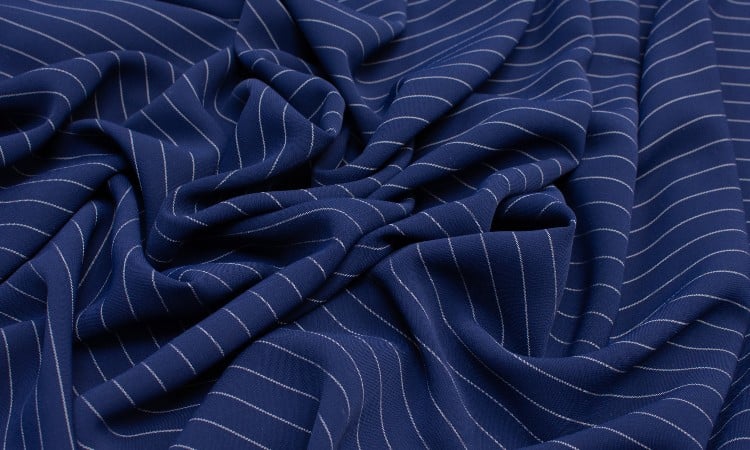
Two types of polyamide fibers go into the production of polyamide fabric. The first is organic polyamides; the second group is synthetic polyamides.
Organic polyamides are natural and formed in a different way to their synthetic cousins. Synthetic polyamides can be broken down into different sub-groups. Let’s take a look at the different forms in a bit more detail.
Organic Polyamides
Wool and silk fibers are both organic polyamides. Being natural, they aren’t called polyamides. They’re known as proteins. As we learned earlier in this article, polyamide is a long chain of similar blocks joined by amides.
The fact there are naturally occurring polyamides in nature tends to get overlooked. Especially as we don’t use the term polyamide to describe either the fibers or the fabric.
When wool fibers are spun together, they form a wool yarn which, in turn, can be knitted or woven into wool fabric. Silk fabric is produced in the same way. Naming the fabric after the fiber is used to make it helps hide its molecular structure. We just think of it as yarn.
Aliphatic Polyamides
This sub-set contains the nylon family which, includes PA6, PA11, PA12, and PA66. An aliphatic polyamide is a linear polymer which means it’s made from a straight chain of monomers. This form of polyamide is completely synthetic and thermoplastic.
Aliphatic polyamides are used in commercial products and are highly successful when used as plastics in engineering. PA6 and PA66 are both widely used in an industrial setting, particularly when the need for high-heat tolerance is required.
Other applications of aliphatic polyamides include carpets, clothing, seatbelts, upholstery, and tire reinforcements.
Aromatic Polyamides
These polyamides are more expensive than aliphatic ones. Because of this, production numbers tend to be lower. Also known as aramids, the most famous example would be Kevlar. One of the biggest uses for aromatic polyamides is bullet-proof vests.
An aramid is extra strong and heat-resistant. Used mainly in military applications or in the aviation industry, aromatic polymers can also be used to make marine cordage and reinforcements for boat hulls. Their heat resistance enables them to be used as a substitute for asbestos.
Polyphthalamids
This group is a semi-aromatic polyamide. Slightly cheaper than their full aromatic siblings, these bridge the gap between aliphatic and aramids.
Polyphthalamids are used in places where the need to withstand extended exposure to harsh chemicals or high temperatures is a must-have. You’re looking at motor parts, fuel line connectors, bushings, air coolers, and heat shields.
Brief History of Polyamide Fabric
Polyamide fabric has been around since the mid-1930s. Originally produced in the USA, it was developed by the DuPont Corporation as a silk stocking substitute. It was launched to a global market at the World Fair in New York in 1939.
The fabric went through a few name changes in its early days. Starting as Fiber 66, those responsible for publicity felt the name lacked marketing appeal. After forming a naming committee, DuPont had a brainstorming session resulting in nearly 400 suggestions.
DuPont wanted to call the fabric No-Run. Initially, the material was believed to be super strong and run-resistant. Unfortunately, as generations of stocking wearers can attest to, the material is incredibly susceptible to runs.
Turning the word No-Run around, the company came up with Nuron, pronounced new-ron. This was considered as an alternative for a while. However, a drawback with that choice was it sounded too much like the nerve toxin, neuron.
DuPont went back to the drawing board. Ernest Knight Gladding, the then head of DuPont’s rayon department, played with a combination of different vowels and eventually came up with the word Nylon.
Used to make parachutes in World War II, nylon became synonymous with strength and durability. When fabric demand outstripped supply after the war, the nylon parachutes were repurposed into garments. The most popular refashions were dresses.
Unfortunately, nylon from the 1940s wasn’t great for apparel and its turn as a clothing fabric didn’t last long. With low breathability and high susceptibility to runs and damage, pure nylon had distinct disadvantages. Coupled with its tendency to melt under too much heat, the fabric waned in popularity.
Environment movements in the 1970s further decimated the attractiveness of nylon and synthetic fabrics in general. As they are derived from crude oil, nylon materials are considered unsustainable and a drain on natural resources.
Although modern-day nylon only makes up a small percentage of today’s synthetic material production, it’s still a popular choice for garments. Over time, the benefits of adding other fibers to the nylon fabric have become more apparent. Blending with wool, cotton and even polyester enhance the characteristics of pure nylon and improve its reliability as an apparel fabric.
How Is Polyamide Fabric Made?
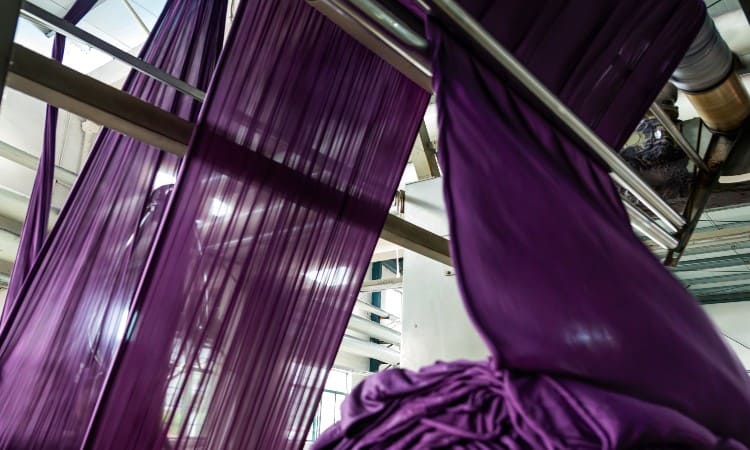
The process of making a polyamide fabric is involved but straightforward. It is carried out in a series of steps that are common to most manufacturers. Differences in the resulting fabric may occur if different blends of fabric fibers are used.
Step 1
The first stage of the process is to extract diamine acid from crude oil.
Step 2
Diamine acid is forced into a mix with adipic acid to create a polymer called nylon salt.
Step 3
Heat is introduced to the crystallized nylon salt until it dissolves to form a hot liquid.
Step 4
This hot liquid is put through a type of die that mimics the spinning action in both spiders and silkworms. Known as a spinneret, the liquid is pushed outwards under centrifugal force until it forms long fibers.
Step 5
The fibers are collected on a bobbin to await the next stage of the process.
Step 6
In the stretching phase, the fibers on the bobbin are put under pressure to stretch them out. This is done to improve the elasticity of the fibers. The stretched fibers are wound onto another spool and sent onwards to the spinning stage.
Step 7
Polyamide fibers are spun into yarn and collected on spools. They are now ready to be turned into fabric.
Step 8
While some fibers are woven into pure nylon fabric, others are blended with fibers from other materials. This creates many different fabrics with diverse characteristics, depending on the mix.
Where Is Polyamide Fabric Produced?
The idea for Polyamide fabric was originally developed in the United States by the DuPont Corporation. Nylon wasn’t trademarked as a brand name as DuPont wanted it to become a generic term for the type of fabric.
DuPont did apply trademarks to both Kevlar and Nomex. They remain the only manufacturer to produce those two specialized forms of nylon. Production takes place at DuPont manufacturing plants throughout the world.
Numerous manufacturers produce standard nylon across the globe. Prolific manufacturers are located in Brazil, China, India, Pakistan, and the USA. China has become the largest producer and exporter of nylon in recent years.
Is Polyamide the Same As Nylon?
Yes, polyamide fabrics can also be called nylon. This was the name given to synthetic fabrics when they were first introduced back in the 1930s. A polyamide is a long chain of monomers joined together by an amide.
There are several different polyamides available, both organic and synthetic. Nylon is one of the better-known synthetic polyamides.
Is Polyamide Breathable?
Breathability depends on the type of polyamide. Organic polyamides are breathable because they are natural fibers. These fabrics include wool and silk.
Synthetic polyamides, like nylon, are artificial, so they cannot breathe. A nylon blend with a natural fiber added like cotton, however, will have some breathability due to the cotton content.
One of the main characteristics of breathable fabric is the ability to absorb moisture and wick it away from the body. Although nylon is synthetic, some forms can attract and absorb moisture to a certain extent.
Polyamides like nylon are a bit like sponges as they will suck up liquid. Nylon isn’t so keen to let it go again, which can be a bit of a problem. Holding the water inside the fabric, nylon can make you feel cold and a little bit soggy.
Depending on the level of saturation, a nylon with a damp surface will dry quicker than one that has been soaked through. The longer the drying time, the more uncomfortable and sticky you will feel.
Is Polyamide Fabric Stretchy?
Polyamide fabric can be stretchy, but it depends on the type of polyamide fabric you have. If you purchase nylon, you can be guaranteed to have a fabric that stretches. Kevlar or Nomex are designed to be bullet-proof or fire-resistant respectfully, so neither of those polyamides has any stretch.
The great thing about nylon is it’s super stretchy. It will also bounce back to its original shape and size when you take the garment off. Better still, it retains its form while you are wearing it, meaning you don’t have any sagging at the knees. This is why it’s fantastic in tights, yoga pants, and leggings.
However, the one thing to watch with nylon is not to overstretch the fabric. Overstretching can cause the material to lose structure and credibility, which leads to runs. This phenomenon is best observed in tights and stockings made from nylon.
Is Polyamide Fabric Waterproof?
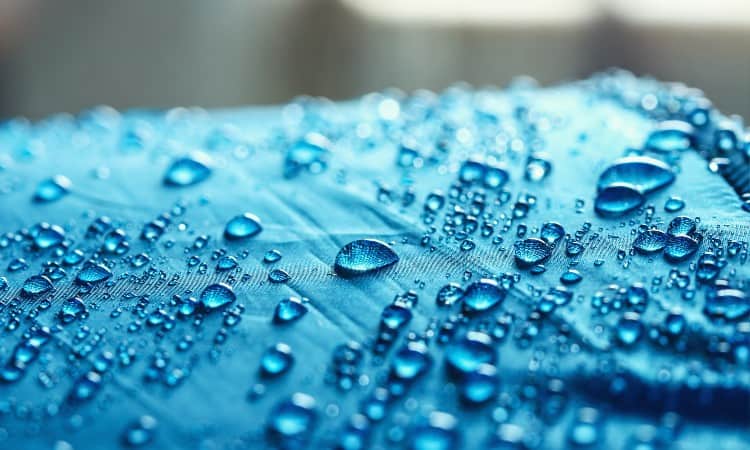
Yes, synthetic polyamide fabric is waterproof. As these polyamides are derived from crude oil they are essentially plastics. Although this does offer waterproof characteristics, the actual effectiveness of the water-resistance depends on the type of polyamide and the thickness of the fabric.
In simple terms, nylon is formed from the crystallization of long-chain polymers. You get lots of chains all bundled up together in a structured pattern. To make it easier to picture this, think of a snowflake.
To be waterproof, the nylon fabric has to have lots of these crystalline snowflake-type structures all packed together, creating a dense surface. The thicker the surface, the better the waterproof qualities. If there are fewer crystals, the fabric isn’t going to be as waterproof. Tights and stockings are good examples of thin nylon that isn’t resistant to water.
Can Polyamide Fabric Be Dyed?
Polyamide fabric can be dyed. However, it’s not always easy to do. As the synthetic variety of polyamide is plastic, your choice of dye is limited. You will need to use a dye specially designed for synthetic or artificial fabric.
Disperse dyes and acid dyes can be used, but, as with all dyes for plastic fabrics, they require heat. This can be a drawback when working with plastic, as it tends to melt under high temperatures. Coupled with the fact synthetic fibers don’t always soak up dye evenly across the fabric, you may end up with blotches. Or a strange two or even three-tone effect instead of an all-over solid shade of the same color.
The easiest way to dye nylon is the same for most plastics. Color is added as part of the production process. This ensures an even shade throughout the garment. Although you can dye polyamide fabrics at home, the safer bet is to purchase the clothing in the color you want and not try to change it.
Is Polyamide Biodegradable?
Polyamide fabric can be biodegradable depending on the type of fabric and the fiber content. Although organic polyamides like wool and silk decompose, identifying a biodegradable synthetic polyamide can be tricky. Basically, some forms of the manmade version are and some are not. Of those that are, the rates of biodegradability are not as good as they could be.
Whether a polyamide is biodegradable is down to the type of polymer it contains. Polyamide 6,6 is better known to us as Polyethylene terephthalate, or rather PET. Now, PET does break down eventually. It takes a while, but it can decompose up to a point. The ease with which it deteriorates makes PET one of the more popular plastics for recycling.
In all its forms, nylon is a polyamide that doesn’t decompose or biodegrade. It can last in a landfill for hundreds of years. However, some nylons can be recycled. It’s not as easy to recycle nylon as it is PET, but it is possible.
Nylons and plastics in general, particularly those used to make food containers, will have a number stamped on them. This number will let you know the kind of plastic it contains and whether it can be recycled. Check with your local recycling facility to see if your nylon items can be recycled instead of left in a landfill.
Is Polyamide Fabric Safe to Wear
Synthetic polyamide fabrics like nylon contain harsh and toxic chemicals. Clothing manufacturers take steps to ensure garments made from polyamide fabrics are safe to wear. Used correctly and per the instructions of the manufacturer, clothing made from synthetic polyamide is considered safe.
Having said that, the fabric does contain chemicals that have known toxicity levels. Wearing any kind of synthetic material for long periods can be damaging to your skin. Plastic fabrics do not breathe and can trap bacteria. This can cause a buildup of odors or lead to skin infections.
Some synthetic fibers have been known to outgas volatile organic compounds, VOCs for short, causing nausea, headaches, dizziness, and breathing issues. Making regular skin contact with the material a health hazard.
Although this all sounds bad, synthetic fabrics are a part of everyday life and difficult to avoid completely. To ensure a healthy balance between your body and the fabric, try to limit the number of synthetics you wear next to your skin. Used in moderation and as intended will help keep synthetic fabrics safe to use.
Polyamide Fabric Uses and Applications

Polyamide Fabric has a range of diverse uses and applications. As it comes in different thicknesses and types, it’s an incredibly versatile fabric. Here’s a list of some of the things it can be used for:
- Tights and stockings
- Underwear
- General clothing
- Outerwear
- Bullet-proof vests
- Flame retardant clothing
- Rope
- Kitchen utensils
- Carpets
- Fishing line
- Tents
- Medical products
- Tire reinforcements
- Motor parts
How Much Does Polyamide Cost?
The price for polyamide fabrics can vary depending on the type of polyamide used and the weave of the fabric. Compared to a silk polyamide fabric, the synthetic nylon version would cost a lot less. However, not all nylons are cheap. Kevlar and Nomex are used for specialized products and can be very expensive.
Another contributing factor to the price of polyamide garments, in particular, is the retail store or designer that made the item. A top brand name available from a high-end store is going to set you back a lot more than a similar generic product from a factory outlet.
Then there is the quality of the fibers used in the construction of the fabric. Lower-quality material will cause a reduction in the value of the product. As with all things in life, you get what you pay for. Higher quality garments using better quality fibers will be more expensive.
What Is Polyamide Yarn?
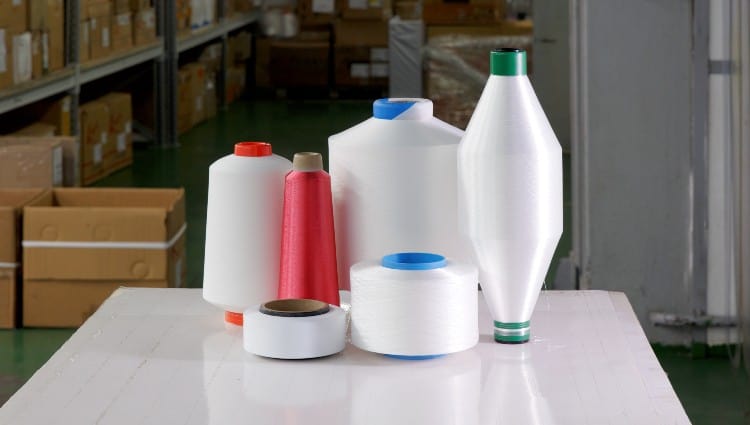
A polyamide yarn is a blend of natural and synthetic fibers used to create a strong, durable string or yarn. This lightweight yarn is used in knitting and crochet to produce items that need extra strength and elasticity. A popular use for polyamide yarn is to knit it into socks.
Adding nylon to a natural fiber like wool creates an incredibly soft and light yarn with the best characteristics of both materials. The resulting garment is easy to care for as the synthetic qualities make it machine washable and easier to dry.
Better still, the elasticity of nylon prevents items like socks from stretching out of shape. Once nylon has been stretched, it always bounces back to its original form. This is incredibly useful for garments under the pressure of moving body parts like feet. The extra give in the nylon makes your home knitted socks stay soft and last a lot longer.
Conclusion
Polyamide fabrics are all around us and pop up in the most unexpected of places. Who knew they could be used to reinforce tires? As it is such a versatile fabric, nylon will be a part of everyday life for years to come. Used correctly, it can be a beneficial and important part of your wardrobe.
Let me know in the comments if you liked the article. Did you know polyamide fabrics were so prolific? Have you used nylon in your crafting projects? How did you get on?